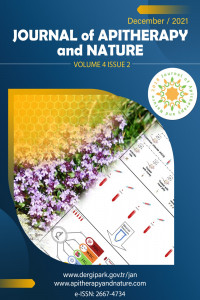Araştırma Makalesi
Amaç ve Kapsam
JAN is the publication of the "Apitherapy and Nature Research Group" established within the (https://avesis.ktu.edu.tr/arastirma-grubu/apiterapivedoga) Karadeniz Technical University.
The Journal Aims:
The Journal of Apitheraphy and Nature isa journal in the field of science and published electronically 2 times a year by Turkish Journal Park Academic and accepts English-language original articles and letters to the editor concerning various fields of research.
These research areas are;
Research Areas | |
· Apitherapy | · Nature Sciences |
· Honey | · Food Science and Technology |
· Pollen | · Food Safety |
· Propolis | · Food Toxicology |
· Royal Jelly | · Chemistry |
· Bee Venom | · Medical and Aromatic Plants |
· Bee Bread | · Clinic |
· Apilarnil | · Environment |
· Api-Air | · Biotechnology |
· Queen Larvae | · Biology |
· Bee Brain | · Cancer |
· Bee Wax | · Pharmacology |
· Forestry | · Drug Design |
· Forest Product | · Other Related Studies on Apitherapy |
· Non-Wood Forest Product | · Other Related Studies on Nature |
The editor may invite reviews covering recent developments in particular fields of interest. Contribution is open to researchers of all nationalities
The Journal of Apitheraphy and Nature is indexed by the following databases.
Yazım Kuralları
Submission Process
All manuscripts must be submitted electronically via the Internet to the Journal of Apitheraphy and Nature through the online system for Journal Park Academic at http://dergipark.gov.tr/jan . You will be guided stepwise through the creation and uploading of the various files. There are no page charges. Papers are accepted for publication on the understanding that they have not been published and are not going to be considered for publication elsewhere.
The Copyright Transfer form should fill up online after acceptance of the manuscript via e-mail to journal’s technical assistant.
The form is available on journal web.
No additions can be made later by the authors on the articles decided to be published. Manuscripts may be rejected without peer review by the editor-in-chief if they do not comply with the instructions for authors or if they are beyond the scope of the journal.
Manuscripts Presentation
Please read author guidelines first. You can find more detail in JAN article template which are presented in the style of a typical article, and offer suggestions on how to format a manuscript.
· Manuscripts should be written double space on A4 sized typing paper with 2,5 cm all margins.
· Text should be prepared using Microsoft Word Processor with Times New Roman font and 12 point size. All lines must be numbered.
· The manuscripts should be divided into following parts. Main parts should be numbered sequentially (1. Introduction, 2. Materials and Method/Methods etc.) and subparts should be numbered 1.1, 1.2., etc. Do not number Acknowledgements and References parts.
Introduction,
Materials and Method/Methods (Area descriptions, Study materials, e.g. should be cited as subheadings),
Results and Discussion,
Recommendations or Conclusions,
Acknowledgements
References.
Every page of the manuscript, including the title page, references, tables, etc., should be numbered.
Cover Letter
Please indicate title of manuscript and authors. You may briefly explain your study. And you may suggest minimum three referee who have similar studies on related work.
Title Information
The first page of your manuscript should be a title information containing the type of paper; the title (Furfural Contents and Some Physical and Chemical Properties of Raisins) The title should be as short as possible, but give adequate information regarding the contents. Title must be written on the center with bold 14 font size.
Author’s Names and Addresses
All authors full names (e.g. Esin CELIK) should be written as lower case with bold 12 font size in the middle. After authors name and surnames, authors addresses should be stated with superscript numbers (e.g. 1 2 3). Corresponding author’s full name should be marked with an asteriks (*). All authors addresses must be typed with lower case 10 font in the center. The corresponding author’s contact address and e-mail address should be given. Names of institutions and cities each authors also must be stated. (Department, Faculty, University, City, Country).
Abstract and Keywords
A brief, informative English and Turkish abstract, not exceeding 300 words, should be typed in 12 font size. The abstract should not contain citations. Immediately following the abstract, authors should provide not exceeding 6 English and Turkish keywords or phrases that reflect content of the article. Acronyms should be avoided. Also, if applicable, you can seperately present your abstract as graphical abstract. The journal costlessly give Turkish abstract translation service for foreign searchers’ manuscript.
Main Text
Main headings and subheadings should be informative, must be typed in capital, bold 12 font size.
Introduction
This part should include the topic and importance of the manuscript and prior works and not contain the findings or the conclusions.
Material and Methods
· The materials and clinical, technical, or experimental methods utilized for the research should be described clearly and concisely.
· When applicable to the research, statistical procedures should be given in sufficient information.
· Previously published articles about the methods should be specified with appropriate references.
· Brand names and company locations should be supplied for all mentioned equipment, instruments, chemicals, etc.
Results and Discussion
This section contain not only findings but also writing comment. Results can be supports by tables, figures, graphics etc., if necessary. Results should be compare with other studies and discuss similarity and distinction.
Latin Terms and Symbols, Units, Abbreviations
Please add the Symbols menu of Word if symbols such as ×, µ, η, or ν are used. Degree symbols (°) must be used from the Symbol menu, not superscripted letter o or number 0. Multiplication symbols must be used (×), not the letter x. Spaces must be inserted between numbers and units (e.g., 5 mL) and between numbers and mathematical symbols (+, –, ×, =, ), but not between numbers and percent symbols (e.g., 27%). Use the dot for decimal units (e.g. 16.07). Please use SI units. All abbreviations and acronyms should be defined at first mention. Latin terms such as et al., in vitro, in situ or microorganisms’ name should not be italicised.
Tables and Figures
· The tables and figures themselves should only be given at the end of the text, after the references, should not be embedded in the main text. Each table should be typed with double spacing on a seperate sheet.
· All tables and figures (graphs, charts, photographs, drawings, etc.) should be numbered consequentially in the order of their citation (e.g., Table 1, Figure 2).
· The tables and figures should have a brief heading indicating the content.
· Heading and footnotes of the tables should be Times New Roman font with 10 point. Headings should be placed above the table and footnotes should be placed below. Descriptor informations should place in footnotes, should not be given in the heading. Explanations of abbreviations used in the table should be made in footnotes.
Ø For example:
Table 1. Physicochemicals properties of the samples.
· Caption of the figures, drawings and graphs should be Times New Roman font with 10 point and be placed below figure, drawing or graph. The figure legends should be given within the figure. It should have the same type and size of lettering that appear in the rest of the figure.
Ø For example:
Figure 2. Classification of phenolic compounds.
· The font type and size used in the table should be Times New Roman and 8 to 12 points.
Acknowledgements
Acknowledgments of people, grants, funds, etc. may be placed in a separate section before the references section. The names of funding organisations should be written in full.
References
· References should be arranged in accordance with the most recent of Publication Manual of the American Psychological Association (APA) guidelines.
You may visit the following links for APA style:
Ø Basics of APA Style Tutorial; (http://flash1r.apa.org/apastyle/basics/index.htm)
Ø APA Formatting and Style Guide; (http://owl.english.purdue.edu/owl/resource/560/01/)
Ø Mini-Guide to APA 6th for Referencing, Citing, Quoting (http://library.manukau.ac.nz/pdfs/apa6thmini.pdf)
· All references should be cited both in the text and the references list.
Citations in the text:
· References in the text should be identified as the last name(s) of the author(s) and the year of publication with a comma between them in parentheses.
Ø For example: (Yildiz, 2013) or (Bilek & Yaygaz, 2014)
· When the citations of two or more studies in the same parentheses, the references should be cited alphabetically by author’s surnames and chronologically for each author.
Ø For example: (Bilek & Yaygaz, 2014; Er, 2014; Yildiz, 2013)
· When an article has three to five authors, all the authors’ surnames should be listed in the first citiation and then should be included only the first author’s surname followed by ‘et al.’ for subsequent references.
Ø For example:
First citation: Yildiz, Kara and Dinç (2015) claims that...
Subsequent citations: Yildiz et al. (2015) claims that...
· When citing more than one publication of the same author(s) in the same year, the references should be cited by the letters a, b, etc. after the year (e.g. Kolayli et al., 2011a, 2011b).
· When there are more than six authors, only the first author’s surname followed by ‘et al’ should be given.
Reference Lists:
Some examples from various reference types according to the current edition (6th) of APA are shown as below:
Journal Article with DOI:
Turkut, G. M., Cakmak, H., Kumcuoglu, S., & Tavman, S. (2016). Effect of quinoa flour on gluten-free bread batter rheology and bread quality. Journal of Cereal Science, 69, 174-181. (https://doi.org/10.1016/j.jcs.2016.03.005)
Journal Article without DOI (when DOI is not available):
Gul, O., Mortas, M., Dervisoglu, M., Er, M., Atmaca, M. & Atalar, I. (2016). Furfural contents and some physical and chemical properties of raisins. Academic Food Journal, 14(3), 235-241.
· When the number of authors is 7 or less in the reference, all authors should be included in reference lists. When there are more than 7 authors; the first six authors’ names should be listed, all subsequent authors except the last should be omitted and replaced with an ellipsis points (...), then the name of the last author should be added.
Ø For Example:
Steel, J., Youssef, M., Pfeifer, R., Ramirez, J. M., Probst, C., Sellei, R., ... Pape, H. C. (2010). Health-related quality of life in patients with multiple injuries and traumatic brain injury 10+ years postinjury. Journal of Trauma: Injury, Infection,
and Critical Care, 69(3), 523-531. doi: 10.1097/TA.0b013e3181e90c24
Book:
Adams, W., Schiraldi, J., & Negi, A. D. (1998). Applications of nanotechnology in
environmental science. Sydney, Australia: Green Guide.
Hayes, D., & Chander, T. (2006). Natural antioxidant agents (2nd ed.). San Diego, CA, USA: Alfa.
Chapter of a Book:
de Ancos, B., Colina-Coca, C., González-Peña, D., & Sánchez-Moreno, C. (2015). Bioactive compounds from vegetable and fruit by-products. In V. K. Gupta, & M. G.Tuohy (Eds.),Biotechnology of Bioactive Compounds: Sources and applications (pp. 1-36). Chichester, UK: John Wiley & Sons.
AOAC. (1995). Total, soluble, and insoluble dietary fiber in foods. In G. W. Latimer, & W. Horwitz (Eds.), Official methods of analysis (16th ed., pp. 7-10). Gaithersburg, MD: AOAC International.
Theses:
Er, M. (2014). Bioactive properties of blueberry extracted with ultrasonic methods and usage in kefir manufacture (Master's Thesis). Available from Council of Higher Education and Theses database. (Thesis No. 374111)
Conference proceedings:
Dizman, S., Yildiz, O., Er, M., Degirmenci, A., Turkut, G. M., & Kolayli, S. (2017). The determination of the radioactıve ray absorption capacity of hazelnut kernel discs. Proceedings of the 9th International Congress on Hazelnut (pp. 105-117). Samsun, Turkey.
Website:
Hagerman, A. E. (2002). Tannin chemistry. Retrieved March 25, 2016 from http://www.users.muohio.edu/hagermae/tannin.pdf
In text referance: e.g. (Hagerman, 2002)
Anonymous. (2005). Acrylamide in food. Retrieved November 01, 2008 from http://www.fao.org/es/esn/jecfa.
In text referance: e.g. (Anonymous, 2005)
Online Newspaper Articles:
Browne, R. (2010, March 21). This brainless patient is no dummy. The Sydney Morning Herald, p. 7.
Meier, B. (2013, January 1). Energy drinks promise edge, but experts say proof is scant. The New York Times, p. 1. Retrieved from http://www.nytimes.com
Lastly
· A list of the corrections requested by the referees must be provided by the authors, and it must be sent to the editorial office via e-mail within a month.
· Studies that are not prepared in accordance with the rules above will not be considered for evaluation.
Etik İlkeler ve Yayın Politikası
Yayın Etiği
The Journal of Apiterapi and Nature dergisi Apiterapi, Doğa Bilimleri, Gıda Bilimi ve Teknolojisi, Gıda Güvenliği, Tıbbi ve Aromatik Bitkiler, Kimya, Orman Ürünleri vb. alanlardaki nitelikli bilimsel makaleleri yayımlamak amacıyla uluslararası çift taraflı kör hakemli bir dergidir ve ücretsiz erişimle elektronik olarak yayımlanmaktadır. Hakemli makaleler, bilimsel yöntemin uygulanmasını, yansızlığı sağlayan çalışmalar olup bu nedenle editörler, yazarlar, hakemler ve okuyucular tarafından aşağıda belirtilen ‘Yayın Etiği İlkeleri’ ne uyulması gerekmektedir. Makalelerde kullanılan verilerin manipüle edilmesi, çarpıtılması ve uydurma verilerin kullanılması gibi durumlar tespit edilirse, makale yazarının çalıştığı kuruma bu durum resmi yollardan bildirilecek ve makale red edilecektir.
Aşağıda yer alan etik ilkeler ve kurallar ‘Yayın Etiği Komitesi’nin (Committe on Publication Ethics - COPE (https://publicationethics.org/)) yönergesine göre hazırlanmıştır.
Yazarların Etik Sorumlulukları
The Journal of Apiterapi and Nature dergisine makale başvurusu yapan yazar(lar)ın etik sorumlulukları
• The Journal of Apiterapi and Nature dergisine gönderilen makaleler belirtilen çalışma alanlarına uygun özgün çalışmalar olmalıdır.
• Dergiye orijinal çalışmalar sunmalıdır. Çalışmaların ve sonuçların başka bir yerde yayınlanmadığı veya yayınlanmak üzere gönderilmediğini beyan etmelilerdir.
• Yazarlar çalışmalarını aynı anda birden fazla dergiye sunamazlar.
• Yazarların makalelerde çıkar çatışması durumunu belirtmeleri ve açıklamaları gerekmektedir.
• Makale yazımı sırasında yararlandıkları kaynaklara doğru biçimde atıf yapmalıdır.
• Makalelerin gözden geçirilmesi sürecinde yazarlardan ham verileri sağlamaları istenebilir. Böyle bir durumda, yazar (lar) bu tür veri ve bilgileri göndermeye hazır olmalıdır.
• Dergiye gönderilen bilimsel makalelerde etik kurul kararı gerektiren klinik ve deneysel insan ve hayvanlar üzerindeki çalışmalar için ayrı etik kurul onayı alınmış olmalı, bu onay makalede belirtilmeli ve belgelendirilmelidir.
Hakemlerin Etik Sorumlulukları
• Hakemlerin makaleleri ayrıntılı, tarafsız ve gizli bir şekilde incelemeleri istenir.
• Hakemlerin yalnızca uzmanlık alanlarına ilişkin makalelere hakemlik yapmaları gerekmektedir
• Hakemlerin değerlendirdikleri makalelere ilişkin Hakem Değerlendirme Formu’nu doldurmaları gerekmektedir. Hakemlerin değerlendirdikleri makalenin yayımlanabilir olup olmadığına ilişkin kararları ile kararlarına ilişkin gerekçelerini de bu formda belirtmeleri gerekmektedir.
• Hakemler yazarlarla doğrudan temas kurmazlar. Yazının gözden geçirme formları ve yorumları editör tarafından yazarlara gönderilir.
• Hakemlerin uslupları yapıcı ve nazik bir şekilde olmalı ve düşmanlık, iftira ve hakaret gibi kişisel yorumlar yapmaktan kaçınmalıdır.
• Herhangi bir çıkar çatışmasının fark edilmesi durumunda, hakem editöre haber vermeli ve makaleyi incelemeyi reddetmelidir.
• Gönderilen çalışmalar değerlendirme süreci bitene kadar hakemler tarafından hiçbir amaçla kullanılamaz.
• Hakemler makaleyi zamanında ve yukarıda belirtilen etik kurallara göre değerlendirmelidir.
Editör, Editör Yardımcıları ve Alan Editörlerinin Etik Sorumlulukları
• Editörler, yayın ilkelerini, dergi hedeflerini ve derginin uluslararası standartlarını değerlendirmekten sorumludur.
• Editörün yayımlanan makalelerin dergi okuyucularının bilgi ve becerileriyle uyumlu olabilmesi için çaba sarf etmesi gerekmektedir.
• Editör sürekli olarak derginin niteliğinin artırılması ve gelişimine katkıda bulunmak için çaba sarf etmekle yükümlüdür.
• Editörler hakemleri konularına ve mesleklerine göre seçmeli ve hakemlerin bilgi ve uzmanlıklarına uygun makaleleri değerlendirmelerini istemelidir.
• Editörler, hakemler ve yazarlar arasında herhangi bir çıkar çatışması olmamasını sağlamalıdır.
• Editörler, kör incelemeye uymalı ve hakemlerin / yazarların kimliklerini gizli tutmalıdır.
• Editörler, yayın kurulu üyelerinin ve hakemlerin makaleleri tarafsız ve bağımsız bir şekilde değerlendirmelerini sağlar.
• Editörün hakem değerlendirme sürecine ilişkin gerekli tüm bilgileri ve hakemlerden yapması beklenenleri hakemlere iletmesi gerekmektedir.
• Editörler, hakemler, yazarlar ve okuyucuların şikayetlerine açık ve aydınlatıcı bir cevap vermekle yükümlüdür.
• Editörler gerektiğinde daima düzeltmeler, açıklamalar, geri çekmeler ve özür yayınlamaya istekli olmalıdır.
• Editör veya Bölüm editörleri gönderilen çalışmaların hangilerinin yayınlanması gerektiğine nihai karar vermekte sorumludurlar.
Etik Dışı Davranış
• Yukarıda belirtilen etik sorumluluklara uymayan etik dışı bir durum, içerik veya davranışla karşılaşırsanız, lütfen aşağıdaki adrese e-posta ile bildirin:
oktayyildiz@ktu.edu.tr
Ücret Politikası
Dergimizde yayınlanan makalelerden ücret alınmamaktadır.
Dizinler
Atıf Dizinleri
Diğer Dizinler
Dergi Kurulları
Baş Editörler

İstatistik Editörü
Ugur SEVIK, Karadeniz Technical University, TURKEY

Yazım ve Dil Editörü
Mehmet KEMAL, Artvin Çoruh Üniversitesi, Türkiye

Dil Editörü
Esma SENEL BINGUL, İzmir Democracy University

Esma Şenel, İzmir Demokrasi Üniversitesi Yabancı Diller Yüksekokulu’nda öğretim görevlisi ve Çanakkale Onsekiz Mart Üniversitesi İngiliz Dili Eğitimi Anabilim Dalı’nda doktora öğrencisidir. Araştırma alanları akademik yazma, hakemlik/akran değerlendirme eğitimi, eğitim teknolojileri, dil öğretiminde yaratıcılık, dil/sınav kaygısı, tükenmişlik ve kültürlerarası yeterliliktir. Uluslararası dergilerde yayınları ve konferans bildirileri bulunmaktadır; Language Teaching Research dâhil çeşitli dergilerde hakemlik yapmaktadır. ABD Büyükelçiliği destekli “English for Media Literacy Across Türkiye (EMLAT)” programında eğitmenlik yapmıştır. EASE, ACSE, IATEFL, TESOL, ve EALTA gibi mesleki derneklerin üyesidir.
Editörler



ASOS Index






